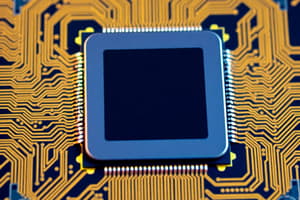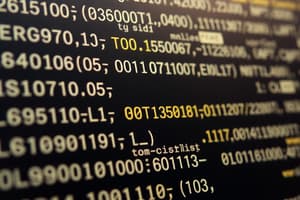Podcast
Questions and Answers
In the context of computer architecture, what distinguishes a special-purpose register from a general-purpose register, and how does this distinction impact the efficiency of specific computational tasks?
In the context of computer architecture, what distinguishes a special-purpose register from a general-purpose register, and how does this distinction impact the efficiency of specific computational tasks?
- General-purpose registers are faster due to their simplified design, while special-purpose registers incorporate error-checking mechanisms that introduce latency but ensure data integrity.
- Special-purpose registers are designed with specific functionalities, such as pointing to the stack or storing status flags, enhancing the speed of context switching and interrupt handling compared to general-purpose registers. (correct)
- Special-purpose registers have larger storage capacities, allowing them to hold more data than general-purpose registers, which is crucial for processing large datasets in memory-intensive applications.
- Special-purpose registers are exclusively used for floating-point arithmetic, whereas general-purpose registers handle integer operations, leading to optimized performance in numerical computations.
How does the Stored Program Concept fundamentally alter the operational paradigm of a CPU, and what are the consequential trade-offs concerning memory management, instruction execution, and system vulnerability?
How does the Stored Program Concept fundamentally alter the operational paradigm of a CPU, and what are the consequential trade-offs concerning memory management, instruction execution, and system vulnerability?
- Storing programs in main memory allows for non-sequential instruction execution, optimizing performance for parallel processing but complicating debugging and program verification.
- The Stored Program Concept reduces the CPU's instruction set, leading to simpler hardware design but requiring compilers to generate more complex code sequences for high-level languages.
- By storing programs in main memory, the Stored Program Concept enables dynamic modification of code during runtime, enhancing flexibility but increasing the risk of security exploits through code injection. (correct)
- The Stored Program Concept necessitates a larger CPU cache to store frequently used instructions, which decreases access time but increases the cost and complexity of the CPU design.
Within the context of machine language instruction design, how do opcode length and complexity influence the instruction set architecture's (ISA) power efficiency, instruction density, and overall system performance?
Within the context of machine language instruction design, how do opcode length and complexity influence the instruction set architecture's (ISA) power efficiency, instruction density, and overall system performance?
- Longer opcodes allow for a larger variety of instructions, decreasing the number of clock cycles per operation but increasing energy consumption per instruction due to the complexity of the decoding logic.
- Shorter opcodes improve instruction density, leading to better cache utilization and reduced memory access latency, but limit the total number of unique instructions the ISA can support.
- Complex opcodes enable the execution of high-level language constructs directly in hardware, significantly boosting performance for compiled applications but increasing the cost of the CPU and the risk of speculative execution vulnerabilities.
- Variable-length opcodes optimize both instruction density and power efficiency by encoding frequently used instructions with shorter codes, but they introduce significant complexity in the instruction decoding pipeline. (correct)
What are the primary architectural trade-offs between Reduced Instruction Set Computing (RISC) and Complex Instruction Set Computing (CISC) concerning code density, power consumption, and suitability for specialized applications like embedded systems and high-performance computing?
What are the primary architectural trade-offs between Reduced Instruction Set Computing (RISC) and Complex Instruction Set Computing (CISC) concerning code density, power consumption, and suitability for specialized applications like embedded systems and high-performance computing?
How does the strategic utilization of machine instruction types such as data transfer, arithmetic/logic, and control instructions facilitate the optimization of program execution speed, memory footprint, and energy consumption within a CPU?
How does the strategic utilization of machine instruction types such as data transfer, arithmetic/logic, and control instructions facilitate the optimization of program execution speed, memory footprint, and energy consumption within a CPU?
In the context of program execution within a CPU, how do the instruction register and program counter interact to orchestrate the fetch-decode-execute cycle, and what mechanisms are in place to handle exceptions and interrupts that disrupt this cycle?
In the context of program execution within a CPU, how do the instruction register and program counter interact to orchestrate the fetch-decode-execute cycle, and what mechanisms are in place to handle exceptions and interrupts that disrupt this cycle?
How can the principles of masking be applied using bitwise logic operations (AND, OR, XOR) to optimize data manipulation tasks such as selective bit modification, flag management, and data encryption within resource-constrained computing environments?
How can the principles of masking be applied using bitwise logic operations (AND, OR, XOR) to optimize data manipulation tasks such as selective bit modification, flag management, and data encryption within resource-constrained computing environments?
What are the inherent challenges and trade-offs associated with employing rotation and shift operations in arithmetic and logical computations, particularly concerning data integrity, overflow handling, and performance optimization across diverse CPU architectures?
What are the inherent challenges and trade-offs associated with employing rotation and shift operations in arithmetic and logical computations, particularly concerning data integrity, overflow handling, and performance optimization across diverse CPU architectures?
Within the domain of computer architecture, how does memory-mapped I/O enable seamless integration of peripheral devices, and what are the implications of this approach regarding address space allocation, interrupt handling, and concurrent data access?
Within the domain of computer architecture, how does memory-mapped I/O enable seamless integration of peripheral devices, and what are the implications of this approach regarding address space allocation, interrupt handling, and concurrent data access?
What are the primary advantages and disadvantages of utilizing Direct Memory Access (DMA) for data transfer between peripheral devices and main memory, specifically concerning CPU utilization, system bus contention, and data coherency management?
What are the primary advantages and disadvantages of utilizing Direct Memory Access (DMA) for data transfer between peripheral devices and main memory, specifically concerning CPU utilization, system bus contention, and data coherency management?
How do parallel and serial communication methods differ in terms of data transfer rate, susceptibility to interference, and application suitability, and what are the key factors influencing the choice between them in embedded systems design?
How do parallel and serial communication methods differ in terms of data transfer rate, susceptibility to interference, and application suitability, and what are the key factors influencing the choice between them in embedded systems design?
How does bandwidth, as a measure of maximum available data transfer rate, influence the performance of networked applications, and what strategies can be employed to mitigate the impact of bandwidth limitations on user experience?
How does bandwidth, as a measure of maximum available data transfer rate, influence the performance of networked applications, and what strategies can be employed to mitigate the impact of bandwidth limitations on user experience?
What are the implications of programming language abstraction on machine-level control, and how can developers reconcile the ease of high-level programming with the need for optimization and direct hardware manipulation?
What are the implications of programming language abstraction on machine-level control, and how can developers reconcile the ease of high-level programming with the need for optimization and direct hardware manipulation?
In the context of parallel processing architectures, what are the defining characteristics and application domains of Single Instruction, Single Data (SISD), Single Instruction, Multiple Data (SIMD), Multiple Instruction, Single Data (MISD), and Multiple Instruction, Multiple Data (MIMD) paradigms?
In the context of parallel processing architectures, what are the defining characteristics and application domains of Single Instruction, Single Data (SISD), Single Instruction, Multiple Data (SIMD), Multiple Instruction, Single Data (MISD), and Multiple Instruction, Multiple Data (MIMD) paradigms?
Considering the complexities of modern CPU design, how do advancements such as pipelining and parallel processing interplay to enhance throughput, and what are the consequential challenges concerning data dependencies, hazard mitigation, and power management?
Considering the complexities of modern CPU design, how do advancements such as pipelining and parallel processing interplay to enhance throughput, and what are the consequential challenges concerning data dependencies, hazard mitigation, and power management?
How does the interplay between advances in computer architecture and programming languages impact the development of secure and resilient software systems, particularly in the face of emerging threats such as Spectre, Meltdown, and Rowhammer attacks?
How does the interplay between advances in computer architecture and programming languages impact the development of secure and resilient software systems, particularly in the face of emerging threats such as Spectre, Meltdown, and Rowhammer attacks?
In the context of Python programming, how does the use of bitwise operators for data manipulation compare to other methods regarding execution speed, memory usage, and code readability, particularly in performance-critical applications?
In the context of Python programming, how does the use of bitwise operators for data manipulation compare to other methods regarding execution speed, memory usage, and code readability, particularly in performance-critical applications?
How can concurrency and parallelism improve data throughput, and what are the most significant trade-offs in overhead, complexity, and overhead?
How can concurrency and parallelism improve data throughput, and what are the most significant trade-offs in overhead, complexity, and overhead?
Regarding control structures like 'if' and 'while' statements in Python, how do they impact the overall structure of a program. If code is written poorly, how will it affect code maintainability, reliability, testability, security, and deployment?
Regarding control structures like 'if' and 'while' statements in Python, how do they impact the overall structure of a program. If code is written poorly, how will it affect code maintainability, reliability, testability, security, and deployment?
In the realm of Python programming, what are the defining characteristics of fruitful and void functions? Are there differences in side effects, state management, and error handling?
In the realm of Python programming, what are the defining characteristics of fruitful and void functions? Are there differences in side effects, state management, and error handling?
Regarding memory-mapped I/O, how does it compare to other ways of communicating to peripherals, what is the data throughput, what are the edge cases, and what are the architectural trade-offs?
Regarding memory-mapped I/O, how does it compare to other ways of communicating to peripherals, what is the data throughput, what are the edge cases, and what are the architectural trade-offs?
Consider a hypothetical CPU architecture where the program counter (PC) is 20 bits wide and the instruction register (IR) is 32 bits wide. The system uses a variable-length instruction encoding scheme where opcodes can be 1, 2, or 3 bytes long, and operands can be immediate values, register addresses, or memory addresses. Memory is byte-addressable. What complications will arise and how can it be handled in the fetch-decode-execute cycle?
Consider a hypothetical CPU architecture where the program counter (PC) is 20 bits wide and the instruction register (IR) is 32 bits wide. The system uses a variable-length instruction encoding scheme where opcodes can be 1, 2, or 3 bytes long, and operands can be immediate values, register addresses, or memory addresses. Memory is byte-addressable. What complications will arise and how can it be handled in the fetch-decode-execute cycle?
In a multithreaded application employing Direct Memory Access (DMA) to transfer data from a high-speed network interface card (NIC) to main memory, which factors most significantly influence overall throughput, and how can potential bottlenecks be addressed?
In a multithreaded application employing Direct Memory Access (DMA) to transfer data from a high-speed network interface card (NIC) to main memory, which factors most significantly influence overall throughput, and how can potential bottlenecks be addressed?
How will SIMD improve matrix multiplication, and what are the trade-offs?
How will SIMD improve matrix multiplication, and what are the trade-offs?
Flashcards
Computer Architecture
Computer Architecture
The fundamental architecture of a computer, including the CPU, main memory, and bus.
Central Processing Unit (CPU)
Central Processing Unit (CPU)
The core of the computer, responsible for executing instructions.
Arithmetic/Logic Unit (ALU)
Arithmetic/Logic Unit (ALU)
Performs arithmetic and logical operations.
Control Unit
Control Unit
Signup and view all the flashcards
Register Unit
Register Unit
Signup and view all the flashcards
Bus
Bus
Signup and view all the flashcards
Main Memory
Main Memory
Signup and view all the flashcards
Stored Program Concept
Stored Program Concept
Signup and view all the flashcards
Machine Instruction
Machine Instruction
Signup and view all the flashcards
Machine Language
Machine Language
Signup and view all the flashcards
Reduced Instruction Set Computing (RISC)
Reduced Instruction Set Computing (RISC)
Signup and view all the flashcards
Complex Instruction Set Computing (CISC)
Complex Instruction Set Computing (CISC)
Signup and view all the flashcards
Data Transfer Instructions
Data Transfer Instructions
Signup and view all the flashcards
Arithmetic/Logic Instructions
Arithmetic/Logic Instructions
Signup and view all the flashcards
Control Instructions
Control Instructions
Signup and view all the flashcards
Op-code
Op-code
Signup and view all the flashcards
Operand
Operand
Signup and view all the flashcards
Instruction Register
Instruction Register
Signup and view all the flashcards
Program Counter
Program Counter
Signup and view all the flashcards
Machine Cycle
Machine Cycle
Signup and view all the flashcards
Logic Operations
Logic Operations
Signup and view all the flashcards
Rotation and Shift Operations
Rotation and Shift Operations
Signup and view all the flashcards
Arithmetic Operations
Arithmetic Operations
Signup and view all the flashcards
Controller
Controller
Signup and view all the flashcards
Port
Port
Signup and view all the flashcards
Memory-mapped I/O
Memory-mapped I/O
Signup and view all the flashcards
Direct Memory Access (DMA)
Direct Memory Access (DMA)
Signup and view all the flashcards
Von Neumann Bottleneck
Von Neumann Bottleneck
Signup and view all the flashcards
Handshaking
Handshaking
Signup and view all the flashcards
Parallel Communication
Parallel Communication
Signup and view all the flashcards
Serial Communication
Serial Communication
Signup and view all the flashcards
bps
bps
Signup and view all the flashcards
Bandwidth
Bandwidth
Signup and view all the flashcards
Data Manipulation
Data Manipulation
Signup and view all the flashcards
Function
Function
Signup and view all the flashcards
Function Call
Function Call
Signup and view all the flashcards
Argument Value
Argument Value
Signup and view all the flashcards
Pipelining
Pipelining
Signup and view all the flashcards
Parallel Processing
Parallel Processing
Signup and view all the flashcards
SISD
SISD
Signup and view all the flashcards
MIMD
MIMD
Signup and view all the flashcards
SIMD
SIMD
Signup and view all the flashcards
Study Notes
Computer Architecture
- Includes the Central Processing Unit (CPU), bus, and main memory.
- The CPU contains the Arithmetic/Logic Unit, the Control Unit, and the Register Unit.
- The Register Unit has general and special purpose registers.
Stored Program Concept
- A program is encoded as bit patterns and stored in main memory.
- The Control Unit can then extract, decode, and execute instructions.
- Programs can be altered by changing these contents in main memory instead of rewiring the CPU.
Machine Language
- Machine instruction is when an instruction is encoded as a bit pattern recognizable by the CPU.
- A machine language is the set of all instructions recognized by a machine.
Machine Language Philosophies
- Reduced Instruction Set Computing (RISC) involves simple, efficient, and fast instructions (ex: PowerPC, ARM).
- Complex Instruction Set Computing (CISC) uses many convenient and powerful instructions (ex: Intel).
Machine Instruction Types
- Data Transfer copies data from one location to another (LOAD, STORE).
- Arithmetic/Logic includes operations on bit patterns (+, -, *, /, AND, OR, SHIFT, ROTATE).
- Control directs the execution of a program (JUMP, BRANCH).
Parts of a Machine Instruction
- Op-code specifies which operation to execute.
- Operand provides more detailed information about the operation, interpretation varies depending on the op-code.
Program Execution
- It is controlled by the Instruction register, which holds current instruction, and the Program counter, which holds the address of the next instruction.
- The Machine Cycle repeats Fetch, Decode, and Execute.
Arithmetic/Logic Instructions
- Logic Operations: AND, OR, XOR, used to mask an operand.
- Rotation and Shift Operations: circular shift, logical shift, arithmetic shift.
- Arithmetic Operations: add, subtract, multiply, divide; two’s complement versus floating-point.
Communicating with Other Devices
- Controller handles communication between the computer and other devices and can be specialized or general purpose (USB, HDMI).
- Port is the point at which a device connects to a computer.
- Memory-mapped I/O allows devices to appear to the CPU as memory locations.
- Direct Memory Access (DMA) enables main memory access by a controller over the bus.
- Von Neumann Bottleneck occurs when the CPU and controllers compete for bus access.
- Handshaking is coordinating the transfer of data between the computer and peripheral devices.
- Parallel Communication transfers several signals at the same time on separate lines (computer's internal bus).
- Serial Communication transfers signals one after the other over a single line (USB, FireWire).
Data Communication Rates (Measurement units)
- bps: bits per second
- Kbps: Kilo-bps (1,000 bps)
- Mbps: Mega-bps (1,000,000 bps)
- Gbps: Giga-bps (1,000,000,000 bps)
- Bandwidth: Maximum available rate
Programming Data Manipulation
- Programming languages hide details of the machine.
- A single Python statement maps to one, tens, or hundreds of machine instructions.
- Knowledge of whether the processor is RISC or CISC is not necessary for the Programmer.
- Assigning variables involves LOAD, STORE, and MOVE op-codes.
Control Structures (Python)
- If statement: Conditional execution.
- While statement: Loop execution while a condition is true.
Functions (Python)
- Functions have a name and series of operations, to be performed on parameters.
- Function call is when a function appears in expression or statement.
- Argument Value is the value plugged into a parameter.
- Fruitful functions return a value, while void functions, or procedures, do not return a value.
Other Architectures
- Technologies that increase throughput include Pipelining (overlapping steps of the machine cycle) and Parallel Processing (using multiple processors simultaneously).
- SISD (Single Instruction, Single Data): No parallel processing.
- MIMD (Multiple Instruction, Multiple Data): Different programs, different data.
- SIMD (Single Instruction, Multiple Data): Same program, different data.
Studying That Suits You
Use AI to generate personalized quizzes and flashcards to suit your learning preferences.




